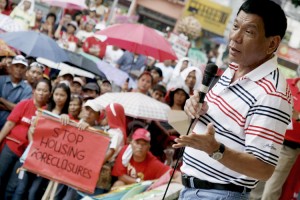A New President for the Philippines
May 10, 2016
Yesterday, May 9, voters in the Philippines elected Rodrigo “Digong” Duterte, the seven-term mayor of Davao (a city in southern Mindanao), to the presidency. Early results indicate that Duterte won nearly 39 percent of the vote, far more than any of the four candidates running against him. Duterte will succeed the current president, Benigno “Noynoy” Aquino, at the end of June. Presidents of the Philippines—often popularly called by their nicknames—are limited to a single 6-year term in office.

Longtime Davao Mayor Rodrigo Duterte won the Philippines presidential election on May 9, 2016.
Credit: Keith Bacongco (licensed under CC BY 2.0)
As mayor of Davao, Duterte gained popularity by cracking down on crime, which once ran rampant in the city. However, critics accuse him of doing so by encouraging vigilante groups to track down and kill criminals. During his presidential election campaign, Duterte promised to fight a “bloody war” on drugs and threatened to kill tens of thousands of criminals. He also made a number of controversial statements on a variety of subjects.
During the campaign, Duterte announced his intention to change the country’s constitution. Among other things, he wants to change the form of government from a central republic to a federal parliamentary system. He has also expressed his desire to spread the power now centralized in “imperial” Manila among the nation’s far-flung regions and provinces. Duterte further pledged to reduce or eradicate the corruption, pollution, poverty, and unemployment that have long plagued his nation. Duterte has yet to give details on how all this might be done.
Filipino voters separately elect the vice president. In that much closer race, Leni Robredo, a social activist, is slightly ahead of Ferdinand “Bongbong” Marcos, the son of former dictator Ferdinand Marcos.


